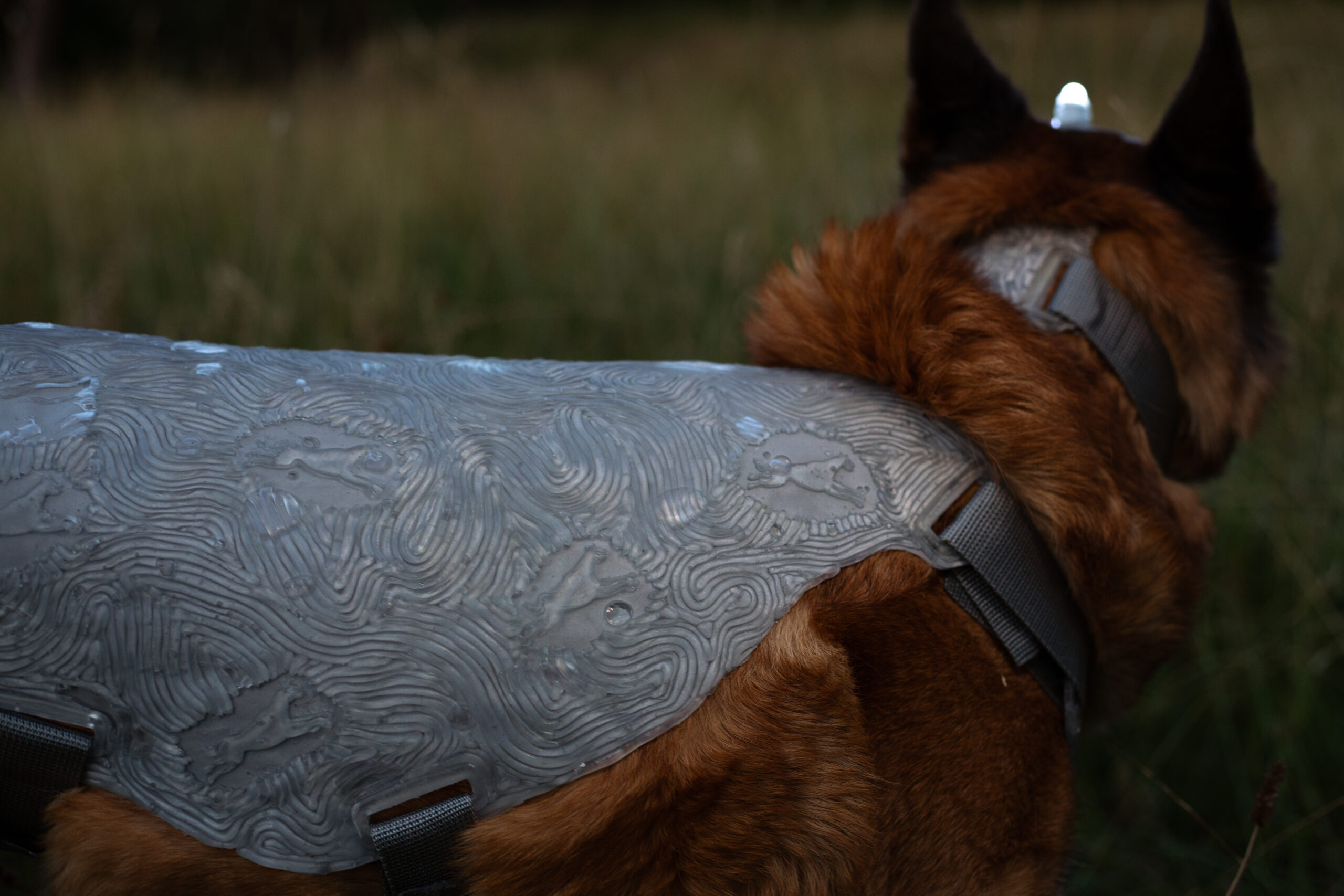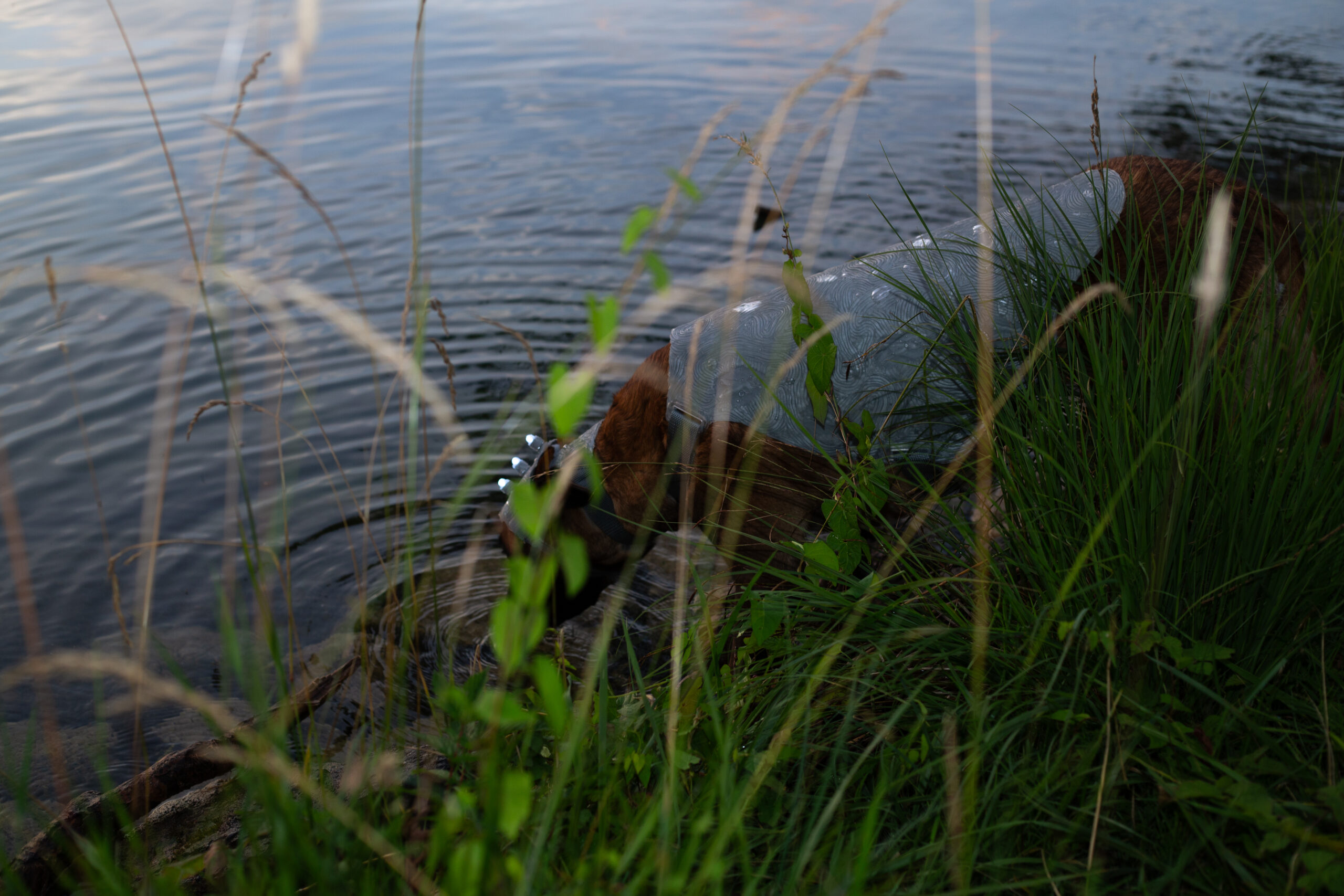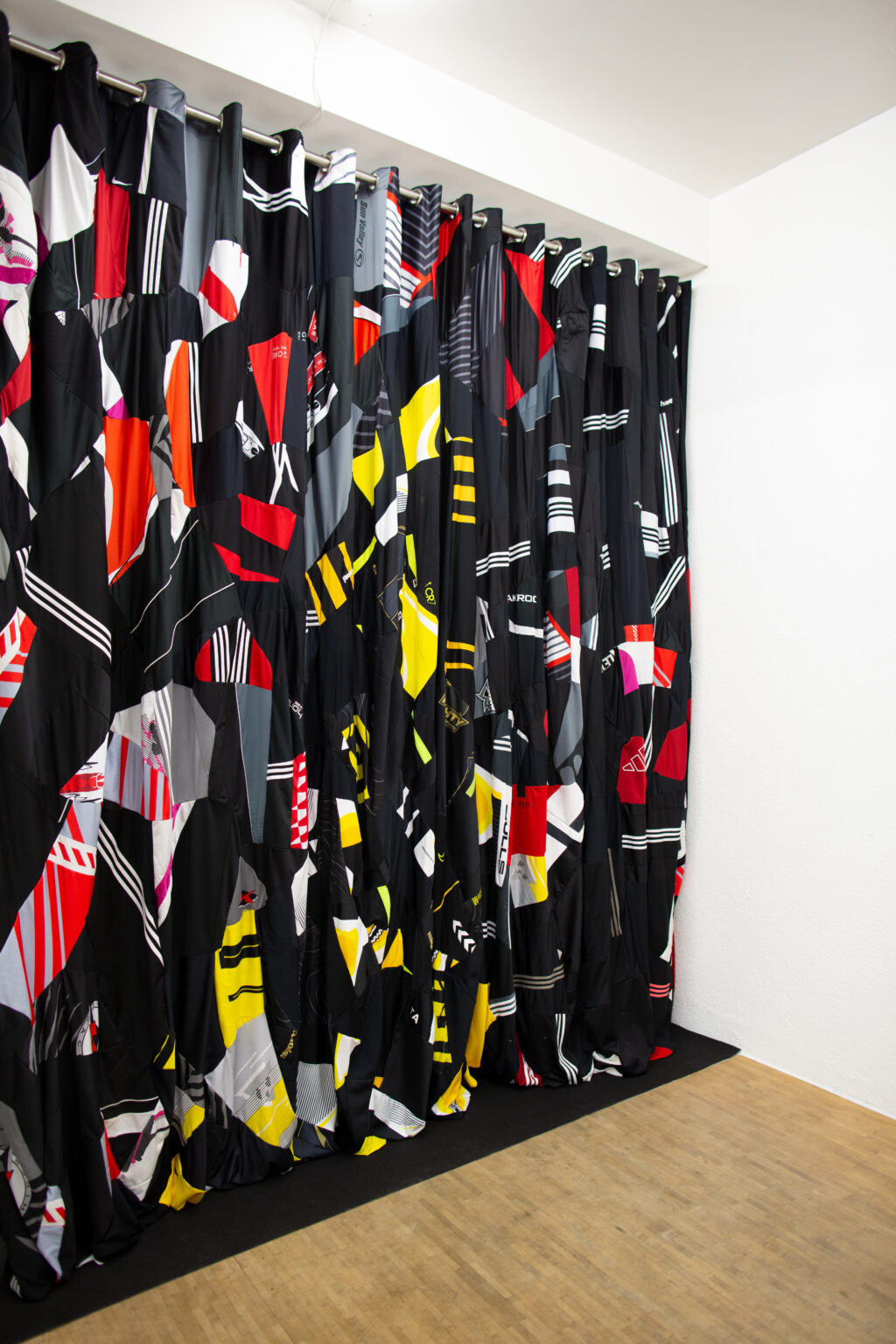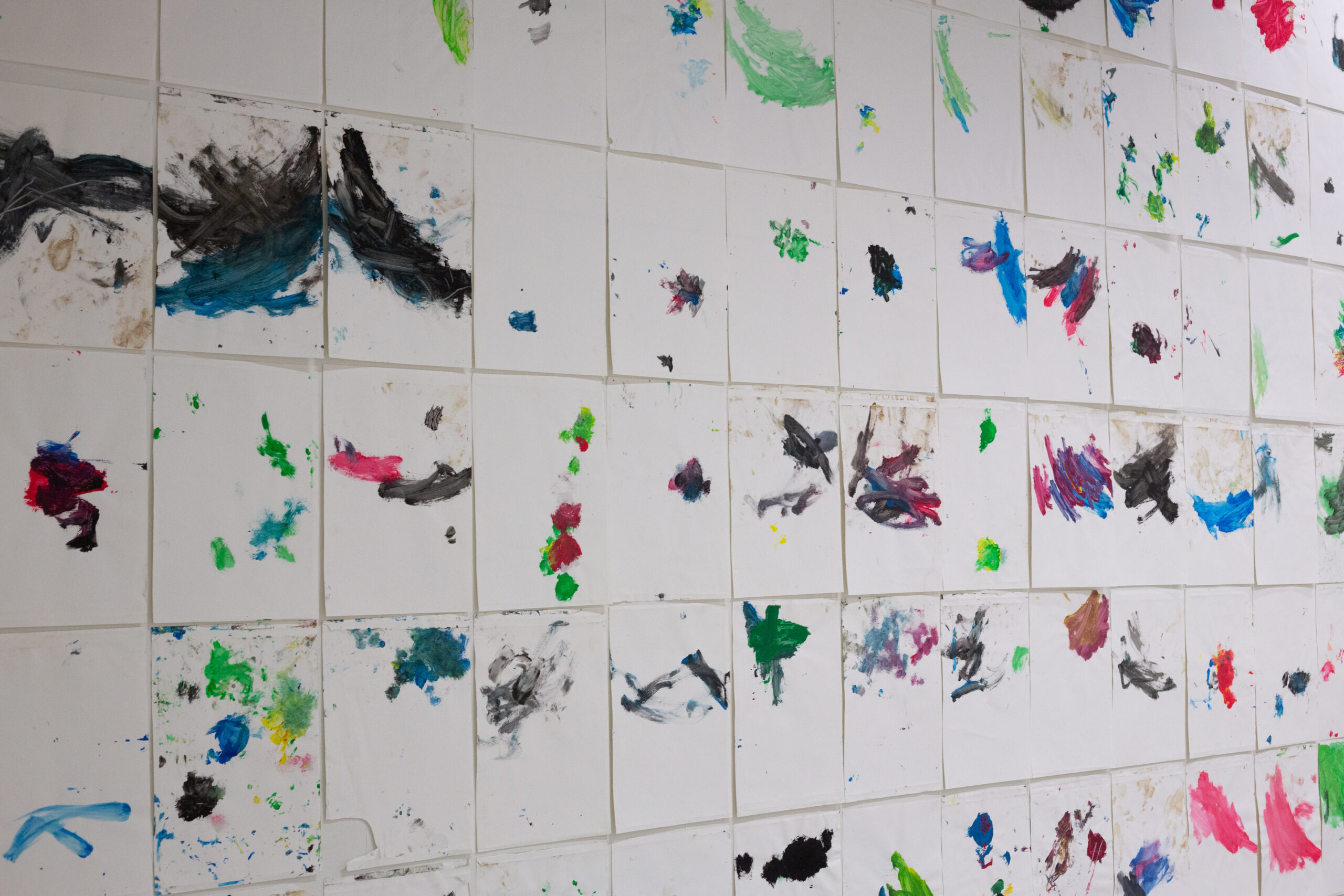While sounds of dogs panting interfere with the soundtrack that is playing on the boat a searchlight is scanning the riverbank for its source. Suddenly a pack of dogs in light reflecting suits appears out of the bushes. Their luminous helmets glow in the twilight while they are roaming the riverside. For a short moment a futuristic world manifests itself. The dogs seem to come from another planet. The suits show neolithic dog presentations referring to that crucial time in history when humans start to settle down with their canine allies some 15’000 years ago. It’s not quite sure what their mission is. Are they here to invade the earth or are they visitors from the future wanting to learn more about their past?






THE PACK
Curtain made out of used sportswear and black velour on the rear side | metallic eyelets | steel tube and mounting construction | 330 x 590cm | 2022
Concept and realisation: Benjamin Egger | Sewing assistance: Iris Rohr | Finish: Polsterei Halbneu | Mounting construction: Benjamin Egger and Urech Metallbau
Sportswear is a specific clothing style in the queer community. The curtain, which is a gigantic patchwork made of used sportswear, refers to that history. Titled THE PACK, it also represents one queer community in particular: Pupplayer. Pupplayers are men who dress and behave as dogs while wearing dog-masks and color-matching sportswear. The sportswear is an important element of the Pupplayer‘s dog-identity, as it manifests the dog-character together with the matching mask. As a patchwork made of countless pieces of used sportswear, the curtain stands for a nongraspable number of Pupplayers entangled together. In that sense, it works like a fragmentation and recompositing of bodies, as in a carpet made of animal fur, for example. It also manifests a soft wall in the space. This protective and permeable wall stands for the pack, the community as a space-building institution in which queerness can be lived in.





SCREW IT. I'M GONNA START MY OWN PLANET
A participatory project in cooperation with the Schütze School, the Migros Museum für Gegenwartskunst and the Blickfelder Festival 22 | 2022
Concept: Benjamin Egger | With: Novak, Samuel, Fabio, Carl, Tenzin, Soha, Elisabeth, Emilia, Danika, Elea, Elis, Janelle, Kimey, Linus, Luca, Melik, Neva, Nicolas, Viola, Tosca, Ariel, Emilia, Erjon, Flurina, Jonas, Lara, Lenn, Loïc, Mai, Malin, Marwin, Konstantin Alea, Anik, Bjordi. Emiliano, Eyla, Jon, Nick, Nina, Paul, Ramazan, Sadie, Tashi | Project management: Tasnim Baghdadi, Cynthia Gavranic | Coordination: Silvia HIldebrand, Marcel Hörler | Teachers: Sabine Duarte, Christian Strupler | Documentation: Raphael Stucky
If things continue as they are, it doesn‘t look so good for quite a few species that will soon lose their habitat due to the climate collapse. Including humans, of course. A group of children from the Schütze school in Zurich has decided to prepare for this. On a newly founded planet, they create a new ecosystem and new creatures under new living conditions. They are inspired by the animal world, endemic species, dinosaurs, and speculative biology. They sketch and perform newly invented species and build models for the prototype of the new planet, at the Migros Museum für Gegenwartskunst.







Start sniffing. Go on all fours. Follow a smell. Don’t talk. Growl when you cross someone’s way. Explore the smell.
Instruction for a fortune cookie, Making a scene, Kunsthal Gent, 2021
THE DOG IN ME
Lecture-Performance | 45‘ 00" | 2021
Text and concept: Benjamin Egger | With: David Attenberger | Costume design: Benjamin Egger, Fantastic Rubber & Florian Germann | Cat-pole: Benjamin Egger and Ortreport | Dramaturgical advice: Teresa Vittucci
Why can’t humans just be animals? In his performance Benjamin Egger is letting a queer fetish-cat lecture the audience. The sassy and ambiguous character embodied by David Attenberger dares the listener to abandon their faith in human exceptionalism. Inspired by theorists of animal ethics, animal studies and queer feminism the cat is taking the audience on a journey to conquer the status quo. While constantly returning to the example of the dog, the cat’s speech is dismantling the dogs as allies of humankind. At the same time it acknowledges them as beings that evolved through their cooperation with these most widespread and destructive mammals. Is it still reasonable to talk about dogs as non-human animals? Or should we not rather call them human animals? And then what?




AND THEN WE TOUCH
Video, Colour | Dolby 5.1 | DCP | 13‘ 30" | 2021
Written and directed: Benjamin Egger | Pupplayers: Aslan & Noah | Cinematography: Andi Widmer | Sound recording and mix: Reto Stamm | Post production: Silvio Gerber | Off-Voice: Darcy Alexandra | Poem: Benjamin Egger | Title Design: Marlon Ilg
A shimmering space opens up when the human is touching the non-human. AND THEN WE TOUCH raises our awareness of the performative nature of categories such as humanity and animality and confronts us with our own needs for sensuality, touch and playfulness as human animals. The viewer becomes part of an intimate scene between two pupplayers in a living room. The close-up cinematography shows the soft touches and playful actions of two men dressed as dogs. In this cinematic essay a post-human identity performed through bodily gestures and grunts is manifested. Becoming animal does not amount to a return to a so-called state of nature; on the contrary, it is a hybrid process, deeply “impure”, in which bodies and artifacts merge.






My hand is touching your fur
Your teeth penetrate my skin
All this togetherness on earth
All these billions of interactions
There are waves, concentric circles
They interfere
Amongst us
And amongst our ancestors
Too
To us, Dears Magazine for tranversal writing practices, Issue 1, 2020
UNTITLED
Series of 24 Water Colours | Each 625 x 880 mm | 2020
The watercolor series Untitled shows 24 different touches of a dog's head by a human hand. Petting a dog can trigger a bilateral release of the feel-good hormone oxytocin. In terms of evolutionary biology, this is crucial for the development of an emotional bond between individuals - be it between mothers and their babies or between humans and dogs. At the same time, petting dogs happens without their consent. The common human behavior is usually ruthless when observed closely. It is practiced with a matter of course that we would not allow ourselves towards another person - here it would have a clearly seem encroaching. In the touch of a dog's head unfolds a millennia-old history of co-evolution and a relationship of inequality and power between human and non-human animals.



MY BODY IS BECAUSE OF DOGS
Video | Colour | Stereo | HD | 14‘ 10" | 2020
Written and directed: Benjamin Egger | Cinematography: Benjamin Egger | Sound recording off-voice: Awah Kempf | Off-Voice: Teresa Vittucci | Text: Benjamin Egger
Benjamin Egger has spent days and nights with a pack of stray dogs in New Delhi. During the nights they are taking over the urban space for themselves. The video shows the pack at night while we are listening to thoughts on the evolutionary entanglement of dogs and human animals from the off. Egger‘s work rises questions about the influence of the dog on the human animal - not only on the social behavior, but also on the biological development. Human animals have lived with dogs for over 20,000 years. How has that shaped the human self-conception? How essential is the bond between these two hyper- cooperative species? How much dog is the human animal?





DOGS
Pigment print on Epson Mat Superior | 841 x 1189 mm | 2019
DOGS shows two different journeys of two different dogs: One is Cäcilie from Munich and the other is Dinkus from New Delhi. Cäcilie is a pet dog, who accompanies her human animal. Dinkus is a stray dog, who is able to range freely at anytime. Surprinsgly it is Dinkus who‘s radius of movement is much smaller than the one from Cäcilie. The print of the over-layered GPS-tracking-data is questioning the common understanding of freedom and at the same time is an illustrative example of the invasive behaviour of human animals documented through the tracking-data of a dog who accompanies one of them.

INHERENT CROSSING
Artistic Research Project | 2012-2017
Concept and lead: Benjamin Egger | Mentoring: Prof. Dieter Maurer and Prof. Carel van Schaik | Cooperation: Institute for Contemporary Art Research of the University of the Arts Zurich, Anthroplogical Insitute of the University of Zurich and Walter Zoo Gossau
Do chimpanzees develop the self-motivation to use a paintbrush if they repeatedly are offered the opportunity to paint? Do they distinguish that handling a brush and paint is mutually related to the application of color and its visual effect? Is it ultimately possible to establish evidence of a pre-graphic or pictorial intention?
A transdisciplinary research team, composed of members of the Zurich University of the Art, the University of Zurich, and the Walter Zoo Gossau, explored these questions. Over the course of twenty months, the Inherent Crossing project offered a group of sixteen chimpanzees the opportunity to participate voluntarily in sessions during which they were able to occupy themselves with painting utensils. Of the sixteen chimpanzees in the group, five were regularly responsive to the offer. One of the female chimpanzees, Blacky, repeatedly indicated a pre-graphic intention in the way she handled the painting utensils. On multiple occasions, Blacky painted solid patches of color, juxtaposed paint applications, and displayed a differentiated treatment of the liquid paint as an imaging material.
For the question of pictorial intention, the actual process in dealing with the utensils is decisive: How are the brush and the gaze directed? Are their movements varied or repeated? Furthermore, however, the sessions in Walter Zoo made clear that the social and spatial conditions, as well as how fit each animal is on a given day, are essential for the animal to pay any attention at all to the brush, paint, and carrier surface. The setting of the sessions, the social constellations within the chimpanzee group, and the individual relationships between the given scientists and apes proved to be central elements in this process. Accordingly, the research team recorded not only the actual act of applying paint, but also the social factors prevalent during each session. Such an expanded focus is decisive for evaluating the study, as merely interpretating the traces of paint would be inadequate.
The study demonstrates, on the one hand, that the question of early graphic behavior among chimpanzees can be discussed only when the individual prerequisites of each chimpanzee are accounted for. It makes clear that a pre-graphic or pictorial intention may potentially be inherent in individual chimpanzees, but that pictorial interest is distinctly individual. On the other hand, it shows that the social parameters that enable a space of contemplation to emerge are of decisive relevance for the participation and development of pictorial processes.







